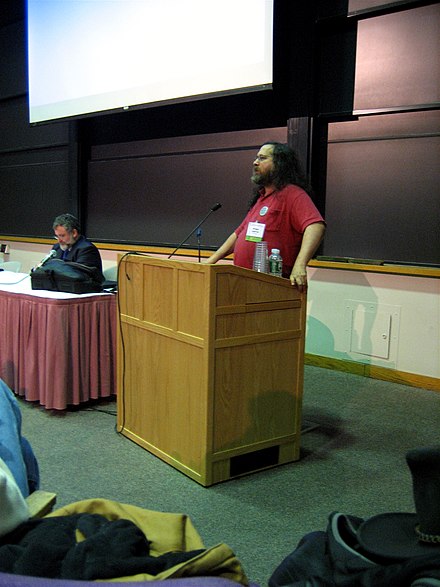GNU General Public License
The GNU General Public License (GNU GPL or simply GPL) is a series of widely used free software licenses that guarantee end users the four freedoms to run, study, share, and modify the software.[7] The licenses were originally written by Richard Stallman, founder of the Free Software Foundation (FSF), for the GNU Project, and grant the recipients of a computer program the rights of the Free Software Definition.[8] The GPL series are all copyleft licenses, which means that any derivative work must be distributed under the same or equivalent license terms. This is in distinction to permissive software licenses, of which the BSD licenses and the MIT License are widely used, less restrictive examples. GPL was the first copyleft license for general use.
Historically, the GPL license family has been one of the most popular software licenses in the free and open-source software domain.[7][9][10][11][12] Prominent free software programs licensed under the GPL include the Linux kernel and the GNU Compiler Collection (GCC). David A. Wheeler argues that the copyleft provided by the GPL was crucial to the success of Linux-based systems, giving the programmers who contributed to the kernel the assurance that their work would benefit the whole world and remain free, rather than being exploited by software companies that would not have to give anything back to the community.[13]
In 2007, the third version of the license (GPLv3) was released to address some perceived problems with the second version (GPLv2) which were discovered during the latter's long-time usage. To keep the license up to date, the GPL license includes an optional "any later version" clause, allowing users to choose between the original terms or the terms in new versions as updated by the FSF. Developers can omit it when licensing their software; the Linux kernel, for instance, is licensed under GPLv2 without the "any later version" clause.[14][15]
The GPL was written by Richard Stallman in 1989, for use with programs released as part of the GNU project. The original GPL was based on a unification of similar licenses used for early versions of GNU Emacs (1985),[16] the GNU Debugger, and the GNU C Compiler.[17] These licenses contained similar provisions to the modern GPL, but were specific to each program, rendering them incompatible, despite being the same license.[18] Stallman's goal was to produce one license that could be used for any project, thus making it possible for many projects to share code.
The second version of the license, version 2, was released in 1991. Over the following 15 years, members of the free software community became concerned over problems in the GPLv2 license that could let someone exploit GPL-licensed software in ways contrary to the license's intent.[19] These problems included tivoization (the inclusion of GPL-licensed software in hardware that refuses to run modified versions of its software), compatibility issues similar to those of the Affero General Public License, and patent deals between Microsoft and distributors of free and open-source software, which some viewed as an attempt to use patents as a weapon against the free software community.
Version 3 was developed to attempt to address these concerns and was officially released on 29 June 2007.[20]


